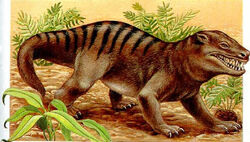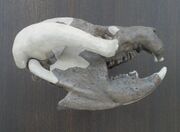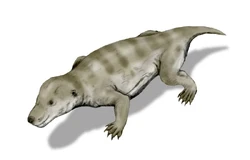| Cynodonts Fossil range: Late Permian - Early Cretaceous Descendant taxon Mammalia survives to present. | |
|---|---|
 Cynognathus | |
| Scientific classification
| |
|
Class |
|
|
Order |
|
|
Suborder |
|
|
See text.
| |
Cynodonts, or dog teeth, are a taxon of Therapsids which includes modern mammals and their extinct close relatives. They were one of the most diverse groups of therapsids. They are named after their dog-like teeth.
Characteristics[]

Bienotherium yunnanense
Cynodonts have nearly all the characteristics of mammals. Their teeth were fully differentiated, the braincase bulged at the back of the head, and many of them walked in an upright manner. Cynodonts still laid eggs, as all Mesozoic proto-mammals probably did. Their temporal fenestrae were much larger than in its ancestors, and the widening of the zygomatic arch allowed for more robust jaw musculature supporting the evidence of a more mammal-like skull. They also have the secondary palate that other primitive therapsids lacked, except the therocephalians, who were the closest relatives of cynodonts. Their dentary was the largest bone in their lower jaw, as other smaller bones moved into the ears. They were probably warm-blooded, and covered in hair.
Evolutionary history[]
- See also: Evolution of mammals

Thrinaxodon from the Early Triassic of South Africa
The cynodonts themselves are part of a group of therapsids called theriodonts, together with the extinct gorgonopsians and the therocephalians. Cynodonts evolved shortly before the end of Permian. The oldest and the most basal cynodont yet found is Charassognathus. Other basal cynodonts were the Procynosuchids, a family that includes Procynosuchus and Dvinia. Cynodonts were among the few groups of synapsids that survived the Permian–Triassic extinction event and had a slow recovery after the extinction.
The most derived cynodonts are found within the clade Eucynodontia, which also contains the members of Mammalia. Representative genera include the large carnivorous cynognathids, equally large herbivorous traversodonts, and small and mammal-like tritylodontids and ictidosaurs. It is likely that cynodonts were at least partially if not completely warm-blooded, covered with hair, which would have insulated them and helped to maintain a high body temperature. The mammal-like structure of cynodonts hints that all mammals have descended from a single group of eucynodonts.
During their evolution, cynodonts' teeth changed from being designed for catching and holding prey and then swallowing whole, to adding specialized teeth, including molars, designed for better mastication of food allowing for quicker digestion. Additionally, the jaw of the cynodonts reduced the number of jaw bones. This move towards a single bone for the mandible increased its structural integrity when compared to the kinetic jaws of reptiles. Several of the bones which were jaw bones in reptiles evolved in this creature to perform an entirely new function, becoming parts of the mammal's middle ear.
Improved hearing gave these creatures a better awareness of their environment and, in turn, this increasing sensitivity called for a greater capacity for processing the auditory information in the brain. Cynodonts also developed a secondary palate in the roof of the mouth. This caused air flow from the nostrils to travel to a position in the back of the mouth instead of directly through it, allowing cynodonts to chew and breathe at the same time. This characteristic is present in all mammals.
Taxonomy and Phylogeny[]





Diademodon.
- Order Therapsida
- (unranked) Eutheriodontia
- Suborder Therocephalia
- Suborder CYNODONTIA
- Charassognathus
- Family Dviniidae
- Family Procynosuchidae
- Epicynodontia
- Family Galesauridae
- Family Thrinaxodontidae
- Infraorder Eucynodontia
- (unranked) Cynognathia
- Family Cynognathidae
- Family Diademodontidae
- Family Trirachodontidae
- Family Traversodontidae
- Santacruzodon
- Scalenodon
- Luangwa
- Traversodon
- Massetognathus
- Exaeretodon
- Family Tritylodontidae
- Oligokyphus
- Tritylodon
- Kayentatherium
- Bienotherium
- Bienotheroides
- (unranked) Probainognathia
- Lumkuia
- Ecteninion
- Family Chiniquodontidae
- Family Probainognathidae
- (unranked) Ictidosauria
- Family Trithelodontidae
- (unranked) Mammaliaformes
- (unranked) Cynognathia
See also[]
References[]
- Hopson, J.A. & Kitching, J.W. (2001). "A probainognathian cynodont from South Africa and the phylogeny of non-mammalian cynodonts." Bull. Mus. Comp. Zool. 156: 5-35.
- Davis, Dwight (1961). "Origin of the Mammalian Feeding Mechanism". Am. Zoologist, 1:229-234.